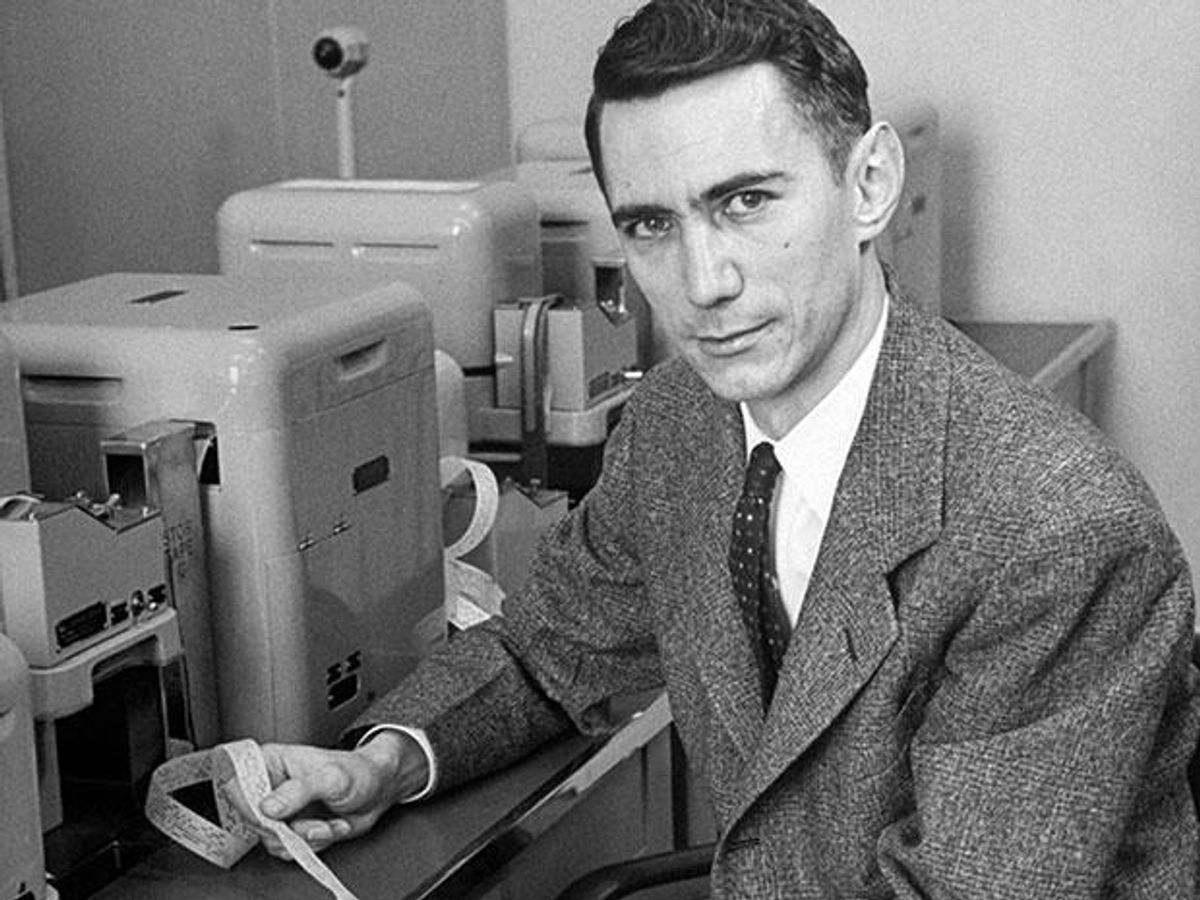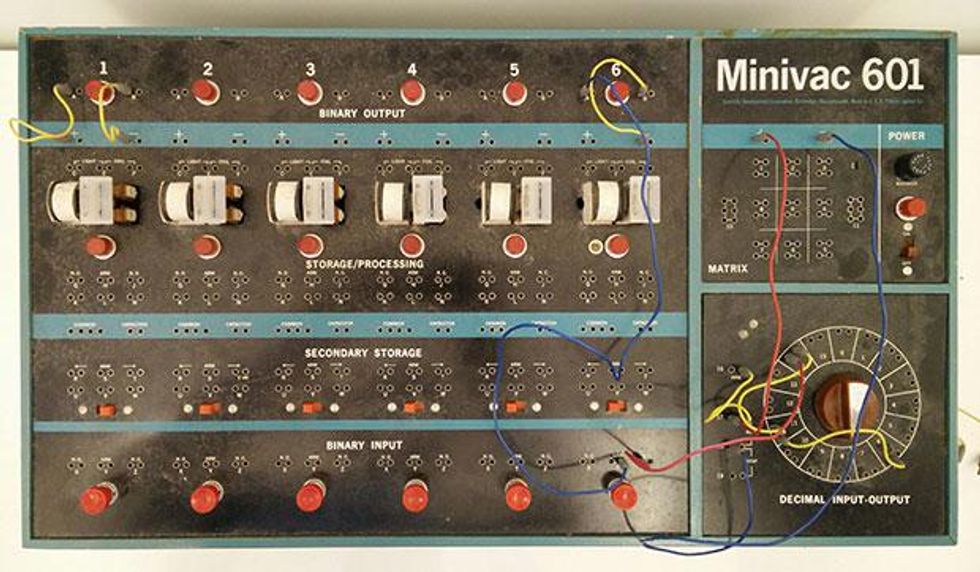Claude E. Shannon [above] would have celebrated his 100th birthday this month on 30 April. Popularly known as the father of information theory, Claude Shannon stated in an interview in 1987 that he kept a carefree attitude by doing “what comes naturally, and usefulness is not my main goal.” Despite this approach to his work, Shannon pursued and solved difficult problems in mathematics and engineering that have had unforeseen benefits for the rest of the world. Although he’s famous for pioneering contributions to cryptography and information theory, Shannon also contributed to the development of personal computers.
In the fall of 1961 advertisements appeared in Popular Mechanics and similar magazines for the Scientific Development Corp.’s (SDC) MINIVAC 601. This “fascinating, compact computer that thinks [and] remembers” was created “as a private project by Dr. Claude E. Shannon, now Donner Professor of Science, MIT, and developed by SDC staff,” the ads proclaimed. The price? US $85 (about $675 in today’s dollars) for a 61-centimeter-wide console “built of professional components to professional standards” that enabled the user “to duplicate control systems like those used in advanced missiles [and] demonstrate data-processing techniques used in business.” MINIVAC 601 could also play games, one ad stated, including “Tic-Tac-Toe, and literally dozens of others.”
At a time when computers were million-dollar systems that took up entire rooms and required trained staff to operate, MINIVAC seemed too good to be true. So why doesn’t it hold a more prominent place in the history of computing, and what exactly was Shannon’s involvement with it?
THE BEGINNING OF BINARY
Unlike the mainframes and early minicomputers of the era, the MINIVAC 601 [right] used electromechanical relays as logic switches and for storage. It had a six-bit binary input/output array, consisting of simple switches and indicator lights, and a motorized dial to input decimal numbers or act as a clock signal.
Because of the current focus on fully electronic, chip-based computers, the MINIVAC doesn’t often rate a mention. It is, however, part of the foundation of more recent machines. Unlike other desktop or kit-based computers of its time, the MINIVAC was a digital machine that was programmed with binary code, which finds its roots in Boolean algebra. The MINIVAC and its predecessors inspired people like RCA’s Joseph Weisbecker, who created and promoted manual, Boolean, logic-based games in the 1960s and electronic digital computers and the first CMOS microprocessors in the 1970s.
In mathematical logic, Boolean is a branch of algebra in which the values of the variables are true and false, usually denoted 1 and 0, respectively. Shannon, as a graduate student at MIT in the late 1930s, discovered that he could apply Boolean principles to designing and analyzing switching circuits, whose components have two basic functions: on and off. His 1937 master’s thesis on this theory became the starting point for the use of binary code in practical applications such as electric circuits and computers.
WHO WAS RESPONSIBLE FOR THE MINIVAC?
Shannon admitted to his lack of passion for computers in that 1987 interview: “I don’t mess around with programming at all. I find that kind of dull, feeding stuff into a computer. Designing computers would be more my taste, but I haven’t been feeling much like it lately. I guess I’ve had a bellyful of that game.” Nor was he motivated by profit. As his wife Betty said, “We don’t really believe in commercializing fun.”
Shannon, who by then had been retired from MIT for nine years, hadn’t felt like designing computational devices since 1954, when he and fellow Bell Telephone Laboratories’ researcher David Hagelbarger proposed an electromechanical relay kit that would cost the company $600 (about $5,275 in today’s dollars) to make. It was intended to help solve the problem of a lack of switching engineers since few universities offered courses in switching techniques or digital controls.
In a memo to their management, Shannon and Hagelbarger wrote that 30 relays and associated components could be mounted on a panel connected to a plugboard through which patch cords would enable several switching circuits. The computer could include circuits for a perpetual calendar, an adding circuit, a telephone exchange, a Morse encoder and decoder, a Tower of Hanoi puzzle, and Nim games. Anticipating that management would be deterred from pursuing the computer because it would take about a year for someone to design, build, and test the circuits and write the manual, Shannon and Hagelbarger also proposed an inexpensive three-relay board that would be simple enough for children or adult hobbyists to use.
The company declined funding of either project. That year, however, computer pioneer Edmund Berkeley contacted the pair to help him commercialize his version of a similar product for children. He had been inspired by Shannon since reading his seminal 1938 article in the Transactions of the American Institute of Electrical Engineers (AIEE was an IEEE predecessor) on Boolean logic and switching circuits. Trained at Harvard as a mathematician, Berkeley was an actuary at Prudential Insurance in nearby Boston. But the potential of Boolean algebra for logical as well as mathematical operations inspired him to pursue the development of computers for individuals as well as for institutions. After publishing the popular Giant Brains, or Machines That Think in 1949, he constructed a series of electromechanical games and robots in the early 1950s.
Shannon and Hagelbarger received permission to work outside Bell Labs in a field of no interest to its parent company, AT&T: children’s games. They collaborated with Berkeley and entrepreneur Oliver Garfield on the GENIAC, an “electrical brain construction kit” that sold for $19.95 (about $175 today) through mail order from 1955 to 1958. The kit included a copy of Shannon’s 1938 article. By then Shannon had left Bell Labs to return to MIT, where he began exploring the issues involved in developing a mechanical hand. Berkeley Enterprises began selling the TYNIAC and BRAINIAC kits, which demonstrated multiple ways to use Boolean logic in electromechanical systems.
How, then, does the MINIVAC 601 fit in? It wasn’t Shannon’s design and it wasn’t Berkeley’s. The device didn’t appear in any of their accounts or papers at the U.S. Library of Congress or the Charles Babbage Institute. Nor does it appear to be one of Garfield’s products after he split with Berkeley. The SDC was located in Watertown a little more than three kilometers from Berkeley Enterprises in Newton, just outside of Boston. The nature of Shannon’s association with the MINIVAC remains unsolved. Can the Institute’s readers help resolve this mystery?
Read Shannon’s oral history on the Engineering and Technology History Wiki to learn more about his career, contributions, and approaches to problem solving. Claude Elwood Shannon: Collected Papers (Wiley-IEEE Press, 1993) contains not only his published articles and other works but the 1987 interview as well.
This article was written by a member of the IEEE History Center, which is funded by donations to the IEEE Foundation.
This article has been revised.




